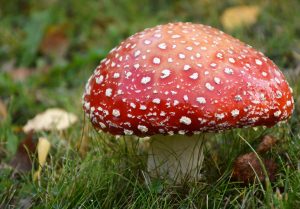Agaricus muscarius, Amanita Muscaria Homeopathic Remedy
Amanita muscaria was first introduced into the Homeopathic pharmacopeia in 1828 by Samuel Hahnemann as a preparation of Agaricus muscarius made from fresh mushrooms.
Homeopathic medicine is based on the principle of similarity; the principle is that small doses of a drug will have a beneficial effect on the symptoms that a large dose would cause a problem or sickness. For example, snake venom, when it enters the bloodstream, affects the cardiovascular system, but in microdoses it successfully treats hypertension and capillary toxicosis. That is why in homeopathy much attention is paid to various poisons, including fly agaric toxins.

Recent studies of agaricus have significantly expanded the list of diseases in which it can be useful.
According to T.D. Popova, as well as many other homeopathic doctors, homeopathic indications for use – or medicinal pathogenesis of fly agaric – reflects the following list:
Characteristic symptoms: twitching, convulsions, itching, burning and feeling of ice needles under the skin, inadequate gaiety with the desire to sing, laugh.
Trembling, twitching, convulsions. Vertigo with a tendency to fall backwards.
It is also a remedy of first importance for twitchings, from simple twitching in face, eyelids (especially) and extremities, to severe cases of chorea (a neurological disorder characterized by jerky involuntary movements affecting especially the shoulders, hips, and face). In the latter disease the twitchings cease during sleep.
Dull headache in the region of the nasal bones. Unilateral headache. Sensation of icy coldness in the head. Extreme sensitiveness of the scalp.
Aversion to communication, any kind of activity, a tendency to uncontrollable fantasy. Ecstatic behavior with inadequate laughter, increased tones in the voice, singing, desire to hug interlocutors. Delusional statements with unwillingness to answer questions asked.
Itching and burning in the eyes. Extreme sensitivity of eyelids to touch. Blepharospasm (convulsive contraction of the eyelids). Blurred vision. Dark flies before the eyes. Myopia (nearsightedness). Diplopia (double vision). Nystagmus (involuntary oscillatory eye movements of high frequency).
Redness and cracking of the lips. Vesicular eruptions over the upper lip.
Redness, swelling, burning, itching of the skin. Sensation of ice needles in the skin, especially in the hands and feet. Violently itching millet-like protrusions. Profuse perspiration in chest at night.
Itching and irritation in the nose. Sneezing with runny nasal discharge. Heightened sense of smell.
Nosebleeds.
Spasmodic cough, especially when the patient is nervous. Hemoptysis.
Short, difficult breathing with the need to take a deep breath.
Increased salivation (salivation). Bitter saliva. Ulceration of the mucous membrane of the mouth, tongue. Halitosis.
Attacks of bulimia (severe hunger), mostly in the evenings.
Belching of air and food. Nausea, vomiting immediately after eating. Heaviness and convulsive pain in the stomach. Bloating. Gas with a garlic odor. Constipation with extremely difficult stool. Dysentery-like diarrhea, especially in children. Burning in the anus (anus). Scanty urine with an admixture of stringy mucus.
Increased libido (sex drive) with flaccidity of the penis. Weakness and sweat after intercourse. Premature, very painful menses, with sensation of prolapse of the uterus. Irritation in the genital region, arousing desire to embrace. Skin irritating leucorrhoea. Itching in the region of the nipples of the mammary glands. Convulsive contraction of the genitals.
Tired feeling in the neck, back, especially when sitting and lying down. Pain in the muscles of the back. Cross joint injury: left arm and right leg, and vice versa. Crackling in the joints.
Sensation of weakness in the extremities, while maintaining sufficient strength in them. Trembling of hands. Cramps in the thumbs.
Numbness, sensation of current, ice-cold needles, increased sensitivity to cold in the extremities.
Feeling worse from cold, nervous tension, in bad weather, from bright sunlight. Improvement at night.
History: chorea, frostbite, alcohol abuse, drugs. Family history: alcoholism, diseases of the central nervous system, rheumatism.
Constitution: increased nervous excitability, exaltation, tendency to convulsions.
Agaricus Muscarius Dosage Instructions (suitable for babies to adults)
For acute and self-limiting complaints, take one pill or five drops of the remedy every 1 to 4 hours (1 hour for intense symptoms, 4 hours for milder ones).
Once an improvement is noticed, stop dosing and repeat the remedy only if symptoms return. If there is no improvement at all by three doses, choose a different remedy or seek professional guidance. Chronic symptoms or complaints require a course of professional treatment to manage the changes in potencies and remedies that will be required.
 Which Potency of Agaricus Muscarius Should I Choose?
Which Potency of Agaricus Muscarius Should I Choose?
The following guidelines apply to home-prescribing for simple, self-limiting complaints.
Low Potencies: 6C and below
Medium Potencies: 30C and 200C
High Potencies: M and above
Lower potencies such as 6C cover a wide range of symptoms, so are ideal if you are not certain that you have chosen the best remedy for your symptoms.
Higher potencies need to match symptoms more precisely if a curative response is to be triggered.
As a general rule, the higher the potency, the longer the effect. A 6C potency may need to be repeated every 1 – 2 hours for a brief period before symptoms improve while an M potency may only have to be given once.
Medium potencies such as 30C are a good choice for home prescribers who have some familiarity with homeopathy. They can be given every 2 – 4 hours until symptoms improve and then only repeated if symptoms return. Improvement should be noticed by 1 – 3 doses if the correct remedy has been selected.
